Mapping the global research landscape on nutrition and the gut microbiota: Visualization and bibliometric analysis
Sa'ed H Zyoud, Muna Shakhshir, Amani S Abushanab, Samah W Al-Jabi, Amer Koni, Moyad Shahwan,Ammar Abdulrahman Jairoun,Adham Abu Taha
Abstract
Key Words: Gut microbiota; Microbiome; Nutrition; Diet; Bibliometric; Scopus; VOSviewer
INTRODUCTION
The microbiome is a term that refers to the collective genomes of microorganisms living in a certain habitat, and the gut microbiota is a complex collection of microorganisms that includes archaea,bacteria, fungus, viruses, and protozoa, among others[1]. These communities interact with each other and their host, with the majority of them being bacteria that reside mainly in the colon of the gastrointestinal tract and interact with them. The human genome has thousands of genes; however, the microbiome contains millions of genes that produce a large number of metabolites that alter host activities, resulting in a substantial impact on the host at the physiological level[2]. Different levels of evidence show that functional or compositional changes in the microbiota present in the human gut contribute to human disease and health, including metabolic, immunological and neuro-behavioral traits that support the role of the microbiota in human health[3,4].
The composition of the gut microbiota varies greatly between individuals. Several studies have found that dietary variations between people are one of the external variables that influence and define the gut microbiota structure[5-8]. Studies in recent years have shown that diet or food as the main source of energy for gut microbes can greatly affect the diversity and components of the gut microbiota, which affects host health[9-12]. In addition to diet, the gut microbiota is affected by different external variables,such as lifestyle and medication (e.g., antibiotics), which mainly affect the microbiota. There are also intrinsic factors that can affect the gut microbiota, such as host genetics, immune and metabolic regulations[13]. Dietary modifications can account for more than 50% of the changes in the gut microbiota changes; however, host genes account for only 10%[14].
Research showed that disturbances in the interaction between nutrients in food and the microbiome affect its structure, which has been shown to be linked to the development of a variety of diseases[15,16]. Long-term or, to a lesser extent, short-term dietary intake modifications could determine each human's stable microbiota profile. For example, regardless of the stage of life, the intake of protein, fat,fermentable or non-fermentable carbs, probiotic, and polyphenol effectively modulates the host's gut microbiota, metabolic, and immunological parameters. Compared to high animal protein consumption and low carbohydrate intake, high consumption increases the risk of various health conditions, such as diabetes, cancer, cardiovascular disease, and irritable bowel syndrome[7,10]. Another evidence on the diversity of bacterial content in the gastrointestinal tract of humans revealed that lower bacterial diversity has been found in individuals with various diseases such as arthritis, inflammatory bowel disease, type 1 and type 2 diabetes, eczema, and obesity than in healthy individuals who support the role of the microbiota in human health and diseases[17-21]. Accordingly, diversity appears as a positive indicator of a healthy gastrointestinal tract[22,23].
The results have been applied to numerous domains connected to the gut microbiota over the last years[24-28]. However, there are no bibliometric analyses of nutrition/diet and gut microbiota publications. As a result, the objective of the present study was to carefully review publications related to nutrition and gut microbiota to assess the current state and hotspots in this field. Therefore, this comprehensive bibliometric study intends to provide an overview of the current state of worldwide nutrition and gut microbiota research and to stay ahead of emerging trends and important turns in the field's evolution.
MATERIALS AND METHODS
Data sources
We performed this bibliometric analysis using the Scopus bibliographic database, which Elsevier B.V.owns. In bibliometric research, only one database is used because bibliometric indicators and literature mapping are difficult to execute on documents acquired from several databases. Furthermore, the grey literature cannot be included in the data retrieved[29,30]. The current analysis was conducted using the SciVerse Scopus database for numerous reasons. First, Scopus has a much larger number and diversity of indexed publications compared to other databases like PubMed or Web of Science. Scopus has nearly the same number of journals indexed as PubMed and Web of Science combined[31]. Second, because all articles listed in PubMed are simultaneously indexed in Scopus, PubMed is completely comprehensive in Scopus. As a result, Scopus is considered to be comprehensive, as it includes papers from both PubMed and Web of Science[29,30]. Third, Scopus publishes publications in a wide range of disciplines,including science, technology, medicine, social science, and the arts and humanities. Fourth, Scopus enables academics to create sophisticated and extensive search queries by combining various Boolean operators. Finally, Scopus enables the researcher to export and examine the data that have been retrieved. This comprises mapping and statistical analysis. Due to the rapid update of the database, the literature retrieval was carried out on a single day (January 7, 2022). Therefore, it was decided that the publication period for this study would be between 2012 and 2021.
Goal definition
The primary goal of this study is to assess the current state and hotspots in the field of nutrition and gut microbiota by examining the scientific production data set related to nutrition and gut microbiota with the goal of characterisation and understanding it in terms of scientometric indices. Based on bibliometric and/or scientometric indicators, the mapping and analysis of scientific knowledge allow the identification of the dynamics and/or expansion of a specific field of study and the support of strategic decisions related to various research institutions[32].
Search strategy
We used the key terms “microbiome or microbiota” and “nutrition or diet” and its synonyms because we are interested in nutrition and gut microbiotaper seas a novel concept in scientific research rather than related subjects. The current study focuses on research papers containing “nutrt* or nutrient* or diet* or eat* or feeding” and “microbiome or microbiota or *flora” to recognize items based on their search in the fields topic and the time was ten years between 2012 and 2021. The asterisk (*) was used in search query to retrieve documents with keywords such as diet or dietary.
Validation of the search strategy
The search query was repeatedly fine-tuned in the current study until the top 100 cited publications in the retrieved literature were free of false-positive results. Furthermore, the search query was checked for missing data (false-negative) using a previously published method that depends on the association between the retrieved research output and the actual research output in this field[29,30]. Instead of a title/abstract search, keywords were used in the title search. As a result, the title search will produce the fewest false positive documents, making it a reliable method[29,33-35]. However, a title/abstract search will show many false positives in which the main focus is not on nutrition and the microbiotaper se.
Bibliometric analysis
The Scopus advanced search tool was used to implement the method. Using the "analyze" function, the retrieved documents were examined. The abstained findings were saved as.csv files in Microsoft Excel.Annual growth, document types, journal names with impact factor (IF), funding agencies, country names, institution names, and document citations were all included in the exported findings. This data was displayed as a linear graph of the annual growth of publication and tables for the core of (top 10 active) journals, funding agencies, countries, institutions, and cited documents in the results section.
式中:Q*,GH,ΔM分别为双堆垛机执行出库任务运行时间的数学期望、货架重心高度、成组货架质量差的绝对值,已于式(10)中详细描述;分别为当代栖息地中,对应各目标函数的最大值。以此为HSI,可以保证:①HSIQ*最大的货位分配方案双堆垛机执行出库任务运行时间的数学期望最小;②HSIGH最大的货位分配方案货架重心高度最低;③HSIΔM最大的货位分配方案成组货架质量差的绝对值最小。
TheImpact Index Per Articlefor the top 10 high-cited papers collected from Reference Citation Analysis (RCA) is presented. RCA is an open multidisciplinary citation analysis database owned by Baishideng Publishing Group Inc. (Pleasanton, CA 94566, United States)[36].
Visualized analysis
Data on terms in titles and abstracts and cross-country collaboration were visualized using the free Web tool VOSviewer 1.6.17 to determine a worldwide scientific cooperation network across countries/regions and examine hotspots and research trends. Nodes in VOSviewer maps are colored and sized differently. The size is related to the number of times it occurs. The node's color shows its relationship to other nodes with similar colors[37].
RESULTS
Number of publications and evolution over time
A total of 5378 documents from the Scopus database were selected for analysis. The documents retrieved were of 11 types, mainly research articles (n= 4223; 78.52%), followed by reviews (n= 820;15.25%). Our findings revealed that the scientific advancement of articles on nutrition and gut microbiota has grown in the past ten years. For example, we found 1295 documents in 2021, compared to only 120 documents in 2012 (Figure 1). Of the 5378 documents retrieved, 89 were clinical trials. Fifteen publications on nutrition and gut microbiota were case reports or case series.
Contributions of countries to global publications
Table 1 Lists the contributions of the top 10 countries in publications related to nutrition and gut microbiota from 2012 to 2021. Topping the list was China, with 1634 items (30.38% of the total), followed by the United States, with 1307 items (second place) (24.3%). Italy (n= 346, 6.43%) and Spain (n= 313,5.82%) ranked third and fourth positions, respectively. An examination of countries with more than 20 publications on nutrition and gut microbiota was conducted. Using data from 44 eligible nations, five VOSviewer clusters were used to examine their centrality and connections to other countries (Figure 2).The United States and China had the highest number of publications in the clusters (green cluster).There is a direct correlation between the number and width of the lines on this map with the degree of interaction and strength between countries.
Analysis of affiliations
As shown in Table 2, the top ten affiliations with the highest number of publications relevant to nutritional science and the gut microbiota were identified. The country with the highest number of affiliations was China. TheChinese Academy of Scienceshad the highest number of publications (n= 138;2.57%), followed by theChina Agricultural University(n= 111; 2.06%), theChinese Academy of Agricultural Sciences(n= 95; 1.77%), and theUniversity College Cork(n= 81; 1.51%).
Analysis of funding agencies
Of the documents retrieved 3271 (60.82%) were publications that were part of funded projects. Again,
Chinese funding agencieswere the most active in this field, theNational Natural Science Foundation of China(n= 711; 13.22%) being the most active, followed by theNational Institutes of Health(n= 327; 6.08%), and theNational Institute of Diabetes and Digestive and Kidney Diseases(n= 190; 3.53%) (Table 3).
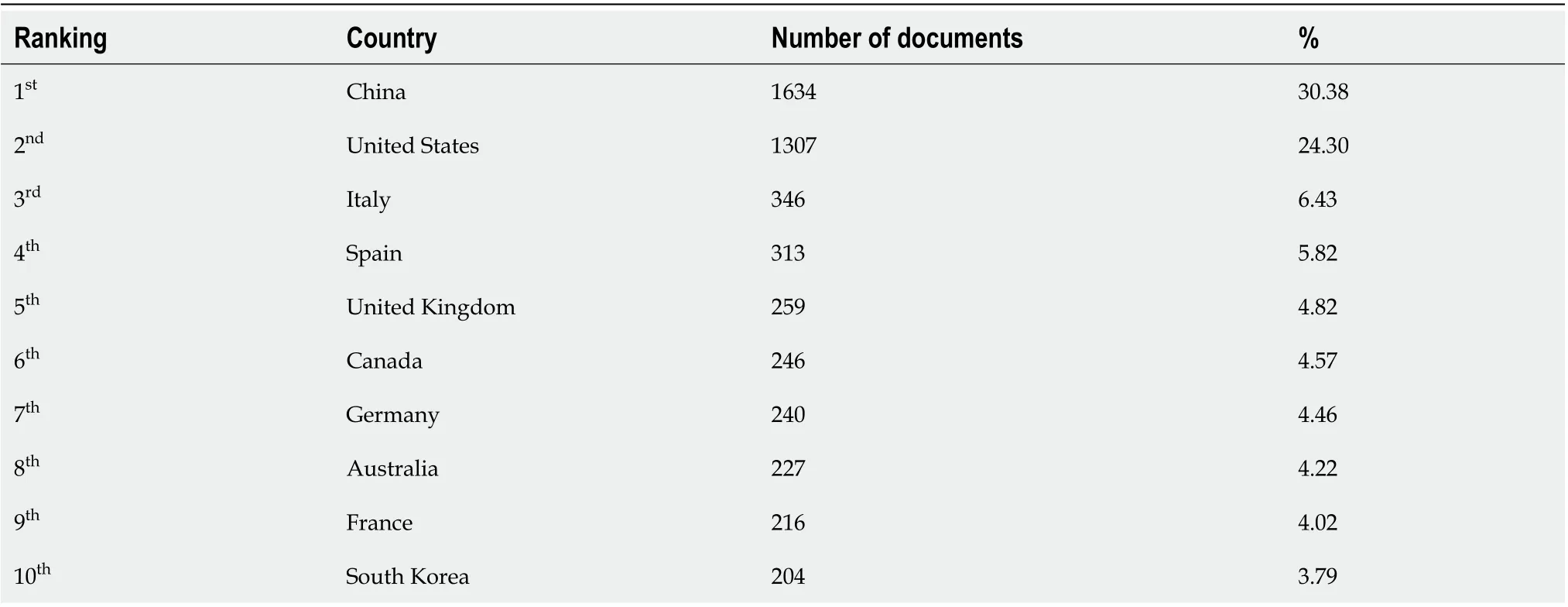
Table 1 List of the top ten countries publishing research on nutrition and the gut microbiota from 2012 to 2021
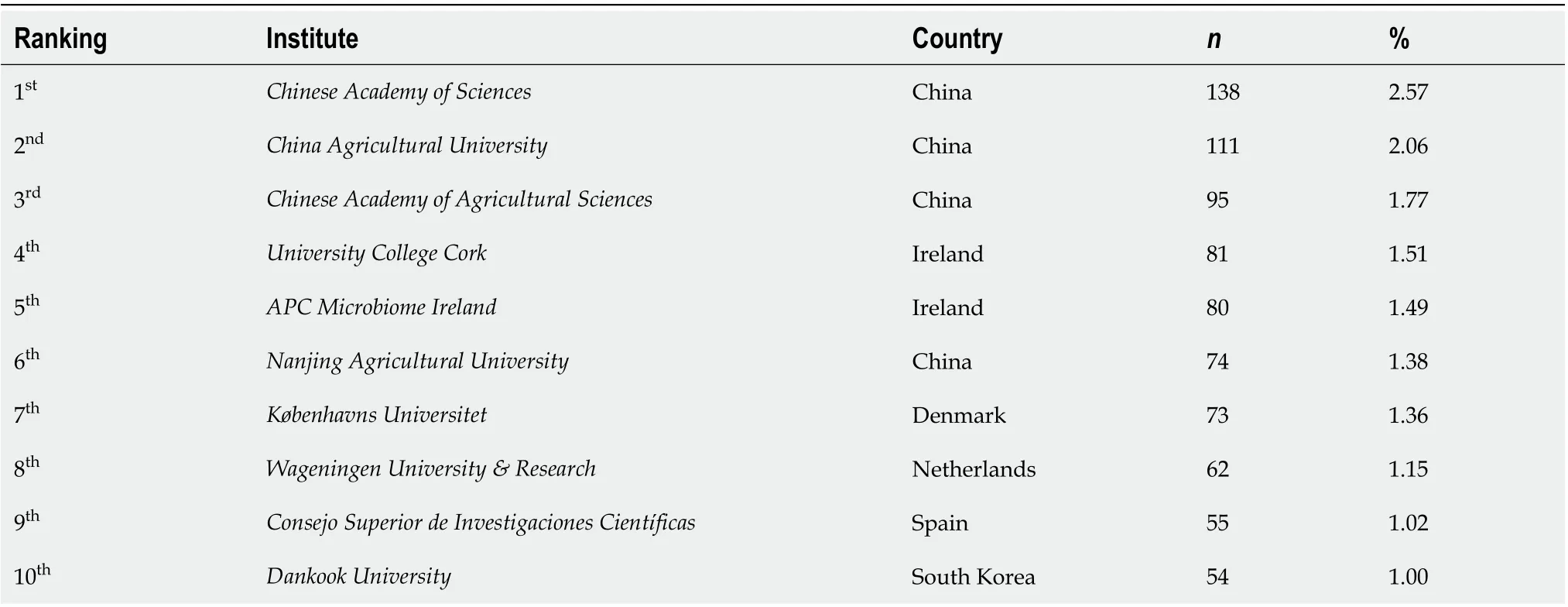
Table 2 The top 10 productive affiliations publishing research on nutrition and the gut microbiota from 2012 to 2021

Table 3 The top ten funding agencies having the most publications on nutrition and the gut microbiota from 2012 to 2021
Journal analysis
As presented in Table 4,Nutrients(n= 271 publications, IF: 5.717) published the most papers on nutrition and the gut microbiota, followed byFrontiers in Microbiology(n= 167 publications, IF: 5.64),andScientific Reports(n= 136 publications, IF: 4.379). The top ten academic journals published approx-imately 22.3% of the publications.
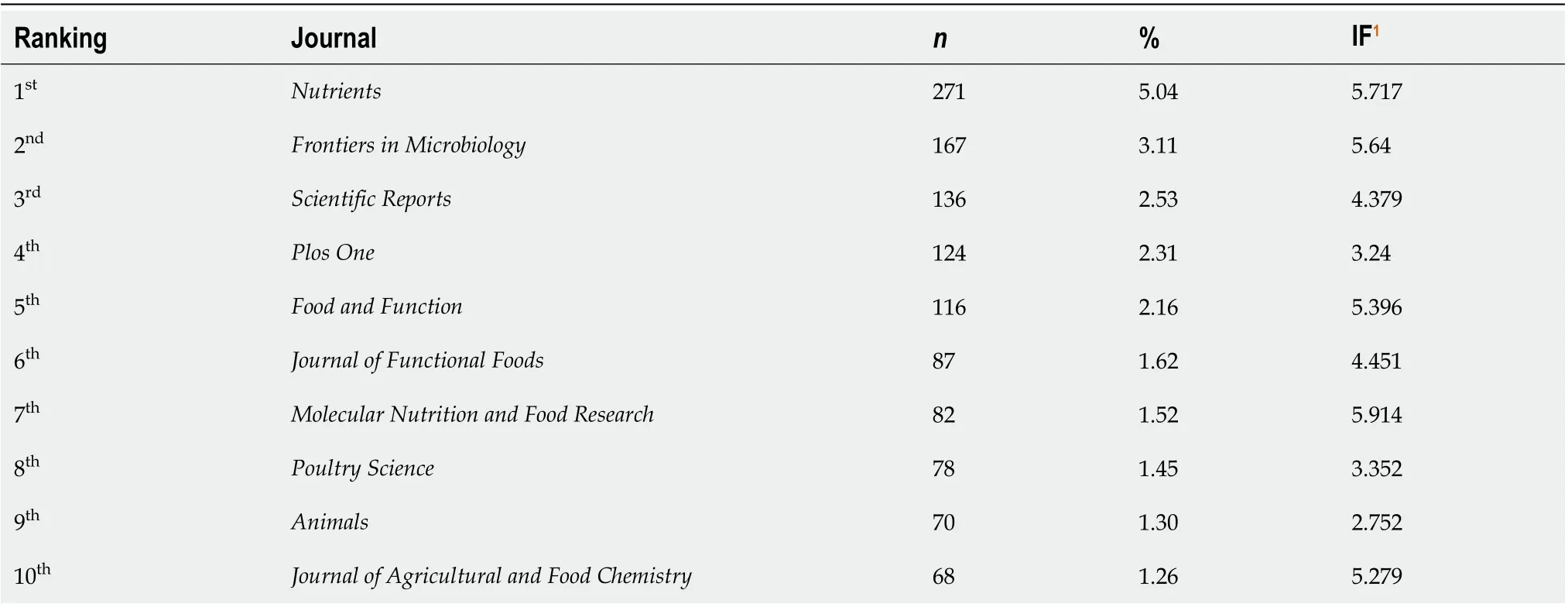
Table 4 The top 10 most active journals publishing research on nutrition and the gut microbiota from 2012 to 2021
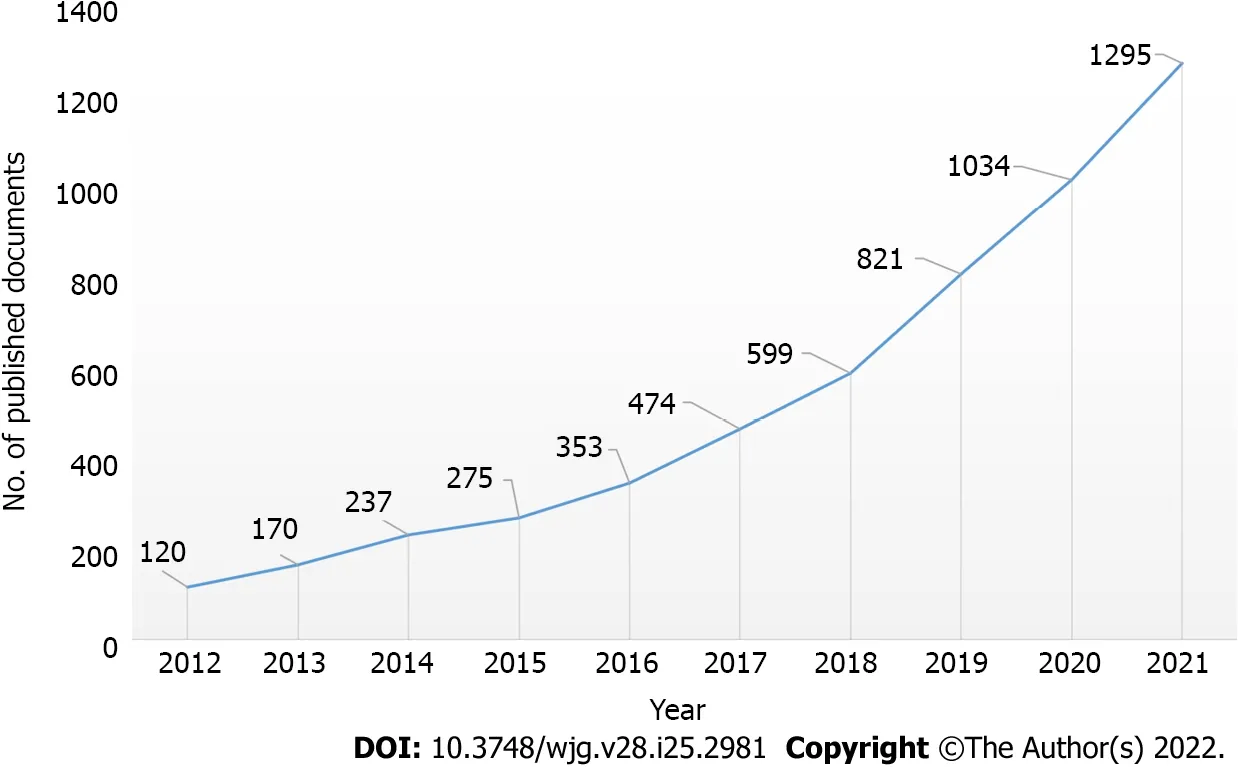
Figure 1 Growth trends of publications on the nutrition and the gut microbiota from 2012 to 2021.
Analysis of research hotspots
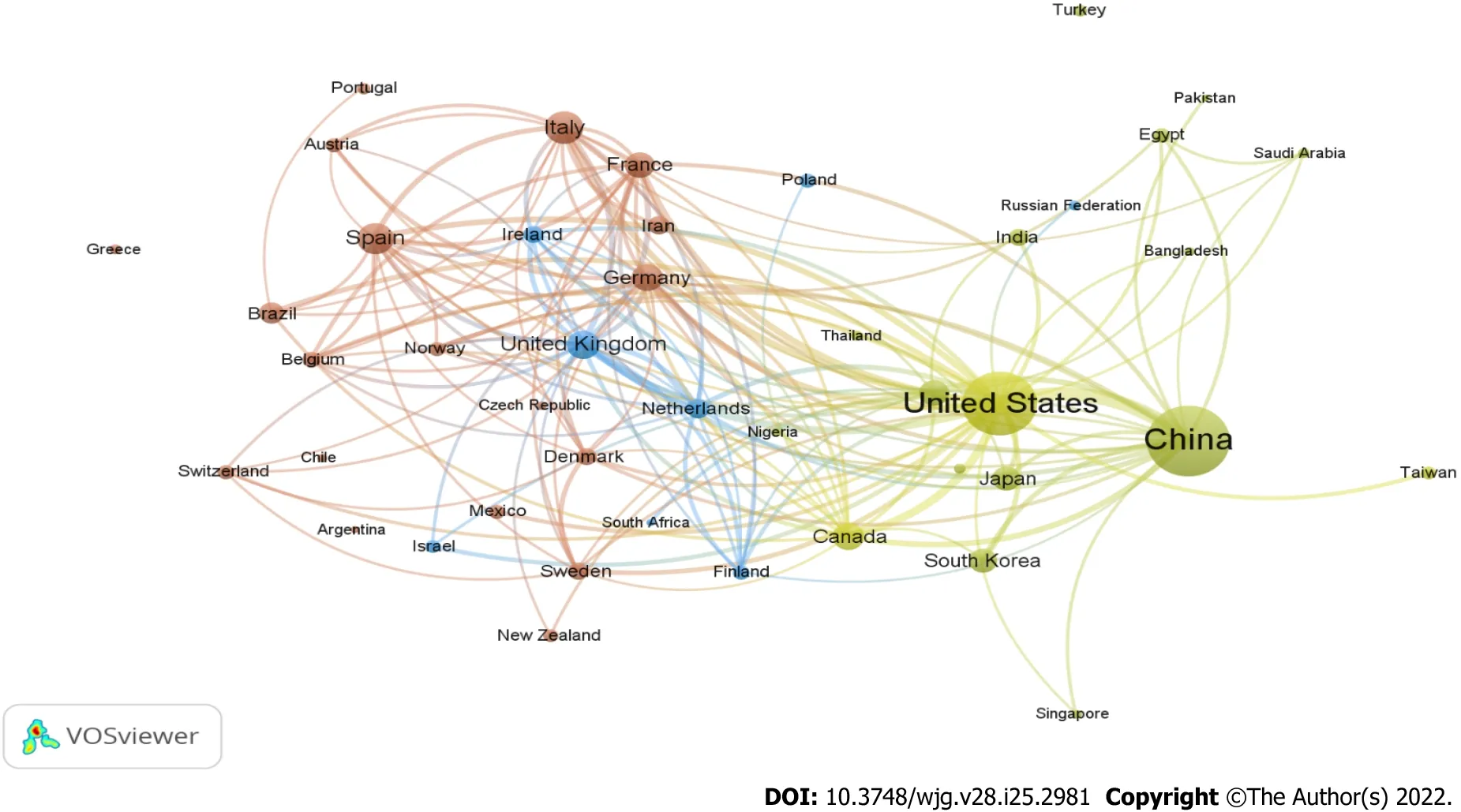
Figure 2 A network visualization map depicting international collaboration in nutrition and gut microbiota research during 2012-2021. This visualized map of collaborations was created after each country had at least 20 publications. Of 154 countries active in this field, 44 countries meet this threshold. The node's size indicates the number of publications for that country.
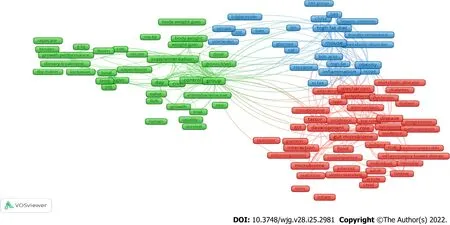
Figure 3 Network visualization map of terms in the title/abstract fields of publications relevant to nutrition and gut microbiota research from 2012 to 2021. When the minimum-term occurrences were put 100 times, this graphical map of terms was created. Of the 85327 terms in this field, 293 achieve this threshold, which were grouped into three clusters and colored differently. The size of the frame shows the number of publications that contain that term.
Analysis of citations
According to citation analysis, the retrieved articles garnered 146101 citations, averaging 27.17perdocument, and an h-index of 154. Citations ranged from 0 to 4588. Two thousand four hundred fortytwo items were indexed with ten or more citations, while 852 were indexed without citations. Table 5 lists the top ten articles with the highest number of articles on research related to nutrition and gut microbiota from 2012 to 2021. The 10 highest citations ranged from 4588 to 796. The impact indexperarticle of the 10 most cited articles ranged from 96.3 to 506.2 (Table 5).
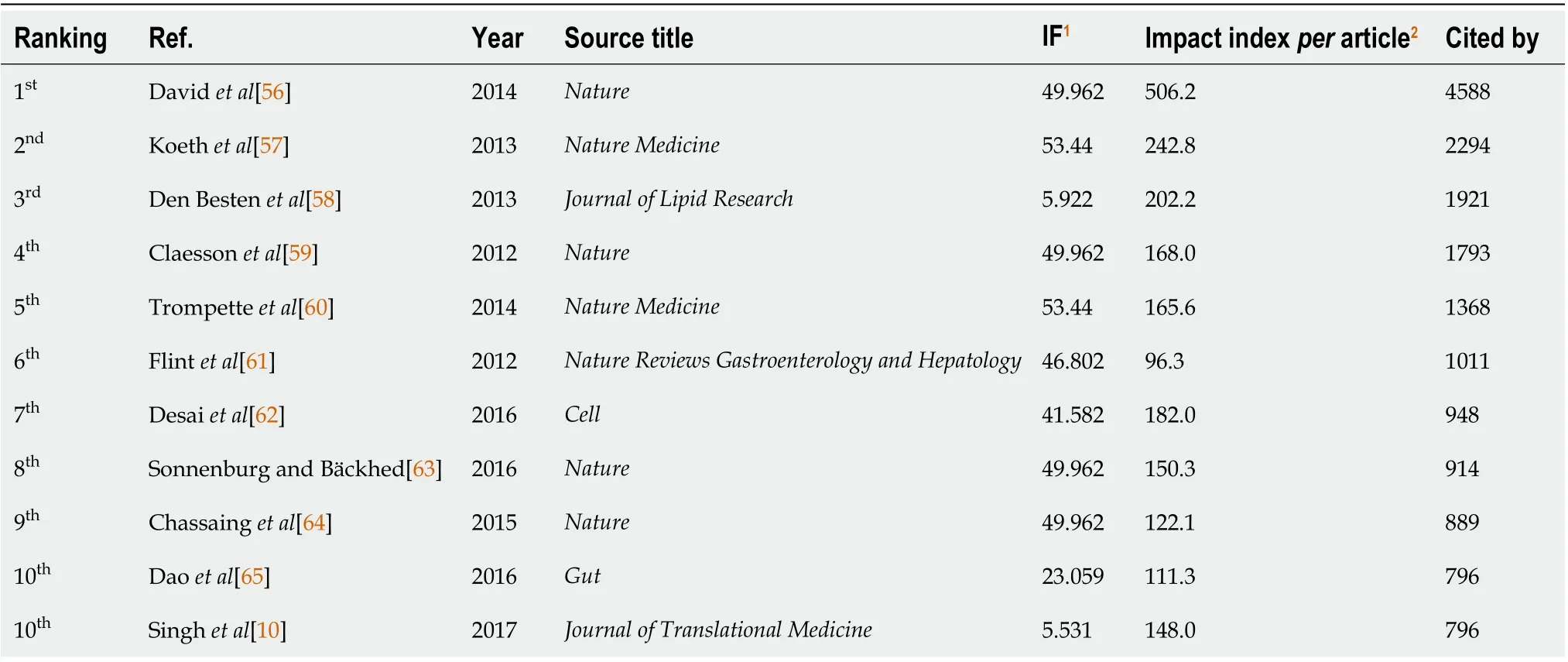
Table 5 The top 10 high cited papers on research related to nutrition and the gut microbiota from 2012 to 2021
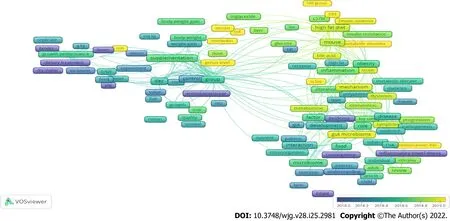
Figure 4 Network visualization map of terms in the title/abstract and their frequency of appearance of keywords is distributed according to the mean frequency of appearance. Blue-colored and green-colored terms first showed, and then yellow terms appeared later.
DISCUSSION
This study has developed research techniques to thoroughly analyze the current status and direction of development of studies related to nutrition and the gut microbiota from 2012 to 2021 using a bibliometric and visualization analysis. The number of publications on the gut microbiota has progressively expanded as the potential clinical implications of the gut microbiota have become better known, and this has become an emerging research subject. Our review of research on global nutrition and gut microbiota found that relevant publications have expanded in the last ten years. A possible explanation for this finding might be that our understanding of the role of the gut microbiota has advanced significantly due to the advancement of scientific tools.
The examination of collaboration networks can provide rich data for evaluating research collaborations and characterizing essential collaborators. China and the United States had a clear advantage in this field, possibly due to their superior economics and investment in the scientific field; for example, in 2013, a notable research project from the United States was launched on the intestinal microbiota-brain axis[38], which resulted in a positive impact on the quality and productivity. In addition, Chinese scientists have made significant advances in the field of gut microbiota[39]. Fecal microbiota transplantation (FMT) has attracted remarkable interest in the treatment of extraintestinal health problems. China registered 84 (24%) of the 367 clinical investigations employing FMT[40]. This is a significant contribution by Chinese researchers to this field and the clinical transformation of studies on the gut microbiota. In addition to FMT research, Chinese researchers are also interested in the development and clinical application of probiotics[41]. Furthermore, one possible reason for the increase in Chinese publication numbers, theNational Natural Science Foundation of Chinalaunched a fund for the role and mechanism of the ‘Gut-Liver Axis’ in gastrointestinal diseases (H03)[42]. This research should focus on the gut microbiota and metabolites, nutrition, neurotransmitters, gastrointestinal hormones,and bile acid, particularly their interactions with the gastrointestinal tract or liver-localized immune cells/factors to mediate a variety of functional roles. Expand on the "gut-liver axis" and its role in the mechanisms of gastrointestinal disease mechanisms to develop novel diagnostic and therapeutic strategies[42].
Furthermore, the increase in publications on the microbiota and nutrition can be attributed to the fact that numerous hot topics were published during this period of time, exposing new theories and establishing new research fields such as the “interaction of the gut microbiota with dietary components”, “connection between the gut microbiota and weight gain”, and “the impact of a high-fat diet and the gut microbiota on metabolic syndrome”. The effect of diet on the gut microbiota and,consequently, on human health suggests new therapeutic and diagnostic concepts and guides to develop probiotic and prebiotic strategies and functional nutrition[43-47].
The ‘effect of a high-fat diet and the gut microbiota on metabolic syndromes’ as a theme was among the main hot topics in the current study. Most publications on nutrition and gut microbiota before 2019 used words such as “connection between the gut microbiota and weight gain" and “interaction of the gut microbiota with dietary components". This was in the early stages of this research area. The “effect of a high-fat diet and gut microbiota on metabolic syndrome” as a theme was one of the main hot topics in this work and was considered the current trend after 2019. As a result, the evidence that emerges proposes that the gut microbiota may play a role in maintaining body weight and energy balance. It is assumed to be fueled, at least in part, by changes in gut microbiota composition caused by high-fat diets(HFDs); HFDs have been correlated with changes in gut microbial profile as well as decreased diversity[48,49]. Furthermore, metabolic syndrome and its associated disorders have been linked to increasing evidence suggesting that the gut microbiota in the digestive tract plays a significant role. Numerous studies in animals and humans have shown that high-fat and high-sugar (fructose) diets are responsible for the three hallmarks of metabolic syndrome: Obesity, dyslipidemia, and insulin resistance by altering the composition and diversity of the gut microbiota[50-53]. Furthermore, there is evidence that HFD is associated with cardiovascular disease[54] because the intestinal microbiota converts dietary choline to trimethylamine, which is absorbed in the gut and converted to trimethylamine N-oxygen. This metabolite causes atherosclerosis in the liver[55].
Strengths and limitations
This is the first thorough bibliometric analysis of nutrition and gut microbiota research conducted on a global level. Research on the relationship between nutrition/diet and gut microbiota is still in its infancy and will expand in the future. The aforementioned growing hotspots serve as a foundation and guide for the development of new projects by scientific researchers, physicians, and medical educators.
Our study has several limitations. First, although Scopus is indeed the largest database available, the search for studies was carried out only from the Scopus database, which could have limited the generalizability of the findings due to the loss of certain documents published in unindexed journals. Second,the accuracy and comprehensiveness of the keywords have a significant impact on the reliability of the data retrieved in our study. As a result, some important and influential articles may be omitted from a representative list due to the use of other terms in their titles. Third, the current study only looked for terms such as “nutrition”, "gut microbiota" and other related terms in the title search only. Papers with these terms in the abstract or text may have been missed in this study. Furthermore, while most publications were published and indexed in 2021, the amount of scientific research productivity this year could be higher because new journal issues are still being published and indexed.
CONCLUSION
To our knowledge, this is the first bibliometric study of trends in publications on microbiota and nutrition. We are entering an era in which we can more easily alter our health through diet and track results using our microbiota or their metabolites. Over the last decade, there has been an increase in the number of publications on the microbiota and nutrition. The top three contributors to microbiota and nutrition research were China, the United States, and Italy. China is the leading country in this area of study, achieving some significant research findings and playing a key role in the progress of the field.“Connection between the gut microbiota and weight gain’, ‘interaction with dietary components” and“the effect of a high-fat diet and the gut microbiota on metabolic syndromes’ were hotspots for gut microbiota and nutrition research in the last 10 years. As a result, our timely examination and analysis of hotspots and research trends may aid in the growth of this discipline. Furthermore, these findings offer a fresh perspective on the study of the microbiota and nutrition/diet, which could help with future etiological research, diagnosis, and treatment of metabolic syndromes.
ARTICLE HIGHLIGHTS
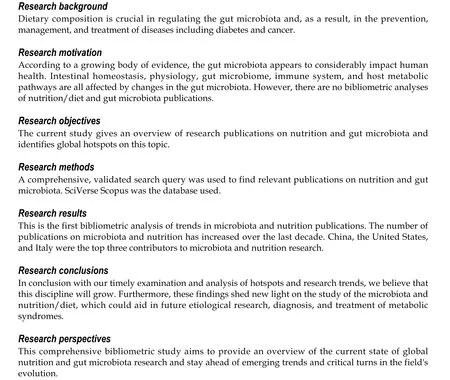
FOOTNOTES
Author contributions:Zyoud SH designed the study, collected the data, analyzed the data, made major contributions to the manuscript’s existing literature search and interpretation, and drafted the manuscript; Shakhshir M,Abushanab AS, Al-Jabi SW, Jairoun AA, Shahwan M, Koni A and Abu Taha A were involved in the interpretation of the data, and made revisions to the initial draft; all authors provided a critical review and approved the final manuscript before submission.
Conflict-of-interest statement:All the authors report no relevant conflicts of interest for this article.
PRISMA 2009 Checklist statement:The authors have read the PRISMA 2009 Checklist, and the manuscript was prepared and revised according to the PRISMA 2009 Checklist.
Open-Access:This article is an open-access article that was selected by an in-house editor and fully peer-reviewed by external reviewers. It is distributed in accordance with the Creative Commons Attribution NonCommercial (CC BYNC 4.0) license, which permits others to distribute, remix, adapt, build upon this work non-commercially, and license their derivative works on different terms, provided the original work is properly cited and the use is noncommercial. See: https://creativecommons.org/Licenses/by-nc/4.0/
Country/Territory of origin:Palestine
ORCID number:Sa'ed H Zyoud 0000-0002-7369-2058; Muna Shakhshir 0000-0002-6213-8457; Amani S Abushanab 0000-0001-6290-787X; Samah W Al-Jabi 0000-0002-4414-9427; Amer Koni 0000-0002-0514-9352; Moyad Shahwan 0000-0001-8367-4841; Ammar Abdulrahman Jairoun 0000-0002-4471-0878; Adham Abu Taha 0000-0002-2889-1138.
S-Editor:Fan JR
L-Editor:A
P-Editor:Fan JR
 World Journal of Gastroenterology2022年25期
World Journal of Gastroenterology2022年25期
- World Journal of Gastroenterology的其它文章
- Non-alcoholic fatty liver disease and the impact of genetic, epigenetic and environmental factors in the offspring
- Role of transcribed ultraconserved regions in gastric cancer and therapeutic perspectives
- Multiple roles for cholinergic signaling in pancreatic diseases
- Early gastric cancer presenting as a typical submucosal tumor cured by endoscopic submucosal dissection:A case report
- Correction to “Aberrant methylation of secreted protein acidic and rich in cysteine gene and its significance in gastric cancer”
- Mechanism and therapeutic strategy of hepatic TM6SF2-deficient non-alcoholic fatty liver diseases via in vivo and in vitro experiments
